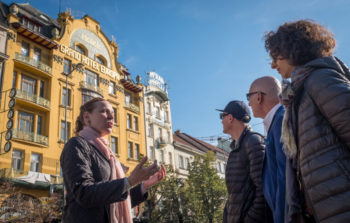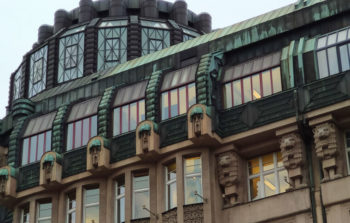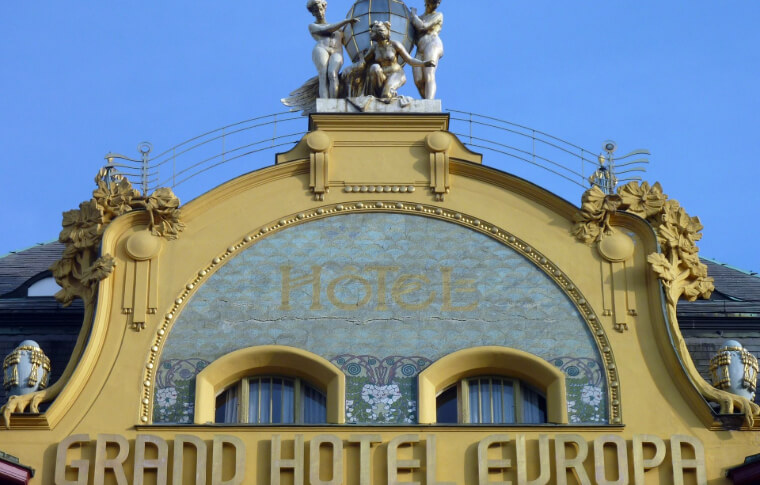The Insight Cities tour of Art Nouveau/Cubist Architecture is a very entertaining and stimulating tour of Prague’s architectural wonders. This tour takes you on a pleasant walk through some of Prague’s most beautiful sites – both the well-known monuments and the city’s hidden gems. During our walk, our guide Bonita offered fascinating details about art nouveau, cubism, and art deco and gave insight into the historical events in Central Europe in the 19th and 20th centuries that led to the formation of these art movements.
Prague at 1900 Walking Tour: Art Nouveau and Cubist Architecture
3-Hour Tour
One of The Guardian’s 10 Best Architecture Tours in the World
Uncover the History that Prompted a New National Style
Explore the radical new design aesthetics that swept across Europe at the turn of the century, on this Art Nouveau and Cubist architecture tour of Prague. With your expert historian guide to lead the way, delve into the dramatic social and political changes that took place in the Czech capital over the 19th and 20th centuries – and discover the ways in which those changes manifested themselves in new design movements across the city. Art Nouveau was embraced by the nationalist cause, which also promoted the invention of Cubist and Rondocubist architecture (building styles unknown outside of the Czech Republic).
Learn to identify the features of Art Nouveau architecture in Prague, from gingko biloba leaves to elaborate lighting fixtures and curvy typography.
Visit the beautiful Lucerna bar (built by Vaclav Havel's grandfather), the elegant Grand Hotel Europa, and Prague's monumental Municipal House.
Admire exquisite interiors throughout Prague, as your expert art historian guide sheds light on the movement's impact on societies across Europe.
Discover key features of Prague's unique Cubist and Rondocubist architecture, including the House of the Black Madonna and the Legiobanka - built to house the accounts of the WWI Legionnaires.
See why this tour was featured in The Guardian as one of the ten best architecture tours in the world, and in The Week as one of the five best architecture tours in Europe.
Tour Details
Price
Private tour – $270 USD (1-10 persons)
*your guide all to yourself
Small groups – $75 USD per person
*still intimate with 8 persons or less
Departure time
Private tours: daily at 10 AM and 2 PM
Small groups:
- Tuesday 10 AM
- Thursday 10 AM
- Sunday 10 AM
Meeting point
Private tours include a pick-up at your central hotel or flat
Small groups: The House of the Black Madonna /
Grand Cafe Orient, Ovocný trh 19, Old Town, Prague 1
Availability
Year-round
Duration
3 hours
Group size
Private tours: 1-10 persons
Groups of over 10 should contact us at info@insightcities.com in order to get a special rate for their party.
Small groups: 2-8 persons
Participation requirements
Our walks operate rain or shine, though, in the case of inclement weather, our guides often make alterations for our guests’ comfort.
What to bring
Comfortable walking shoes
About your guide
Read about our Prague guides
Cancellation policy
For cancellations 48 hours prior to your scheduled tour, Insight Cities offers a full refund. We cannot refund cancellations within 48 hours of a scheduled tour as we need to pay our guide.
Overview of Your Tour

Art Nouveau Across Europe
In France, it was known as Art Nouveau and Style Moderne, and when this modern manner came to prominence at the 1900 World Exhibition in Paris, it became known as Style 1900. It was also referred to as Style Métro (after Paris metro designer Hector Guimard) as well as Style Mucha (after the great Czech graphic artist whose posters are considered Art Nouveau par excellence). In Munich and Berlin, it was called Jugendstil, and in Austria-Hungary, it was known as the Sezession.
Call it what you will, the Art Nouveau movement left an indelible mark across Europe – and it was eagerly adopted in Prague.

Art Nouveau in Prague: a Whirlwind of National Revival Activity
At the end of the 19th and the beginning of the 20th century, Prague was experiencing a whirlwind of national revival activity, and the movement was embodied in the form of Art Nouveau. From the Prague Main Railway Station and the monumental Municipal House, to the entire district of Josefov (the former Jewish ghetto), Art Nouveau architecture represents many of the city’s most significant sites.
During this Art Nouveau walking tour in Prague, you’ll learn to recognize the main features of the Art Nouveau style – from ginkgo biloba leaves on building façades and orientalist influences, to elaborate light fixtures, and curvy typography on shop signs that echo contemporary magazine and poster graphics.
We’ll visit the beautiful Lucerna bar (built by Vaclav Havel’s grandfather) and the elegant Grand Hotel Europa – examples of a moment of Czech optimism at the turn of the century – signaling the region’s transcendence of older ethnic grievances, and its readiness to join Europe by participating in European-wide avant-garde movements.

Cubist and Rondocubist Architecture in Prague; an Important Parallel
As an important parallel, we’ll travel back to the emergence of the Czech Cubist movement and trace its progress as it ultimately became the “national style” – and the only appropriate choice for the 1920’s Legiobanka, built to house the accounts of the WWI Legionnaires who fought for Czech and Slovak nationhood.
We visit examples of Prague’s Cubist and Rondocubist architecture (a building style unknown outside of the Czech Republic), including the House of the Black Madonna (created by Josef Gočár in 1910 as an urbane department store). In many respects, Prague’s Cubist architecture surpassed even Art Nouveau as a statement of the city’s newfound sense of modern sophistication and resurgent national identity.
See Our FAQs for More Information
See What Our Guests are Saying
Bonita showed us hidden gems of Prague architecture many of which I have walked by for more than 2 years without ever realizing they were there. Other sites I had noticed their beauty without understanding their meaning. I already knew Prague is a beautiful city, but after this tour, the beauty really pops! Bonita’s knowledge is deep, and she answered all our questions — and many interesting questions we didn’t know enough to ask. I suspect we only scratched the surface of she knows. I highly recommend this tour.
We went on this tour with Lenka Phillippova as our guide. She has extensive knowledge of the history of Art Nouveau in Prague as well as history in the city. She showed us some amazing sites that we would never have found on our own. Her command of English was excellent. She was passionate about the subject and she graciously shared her time and knowledge with us. We were mesmerized for four hours ! We were lucky to be the only two people in the group so it was a personalized experience. We cannot recommend Insight Tours more highly- registration was easy, confirmation of the guide and meeting place was detailed and helpful. The tour guides are amazing !
Today we were delighted by the art nouveau and cubist delights of Prague’s Old Town. Having already lived in Prague for a few years, I was familiar with some of these buildings and interiors but knew little of their place in both art and Czech history. Bonita Rhoads is an articulate, knowledgeable and passionate tour guide! She easily brought the art alive by placing it within local and international contexts. The art is amazing. The tour is strongly recommended for visitors and residents. Thanks Bonita!!



































